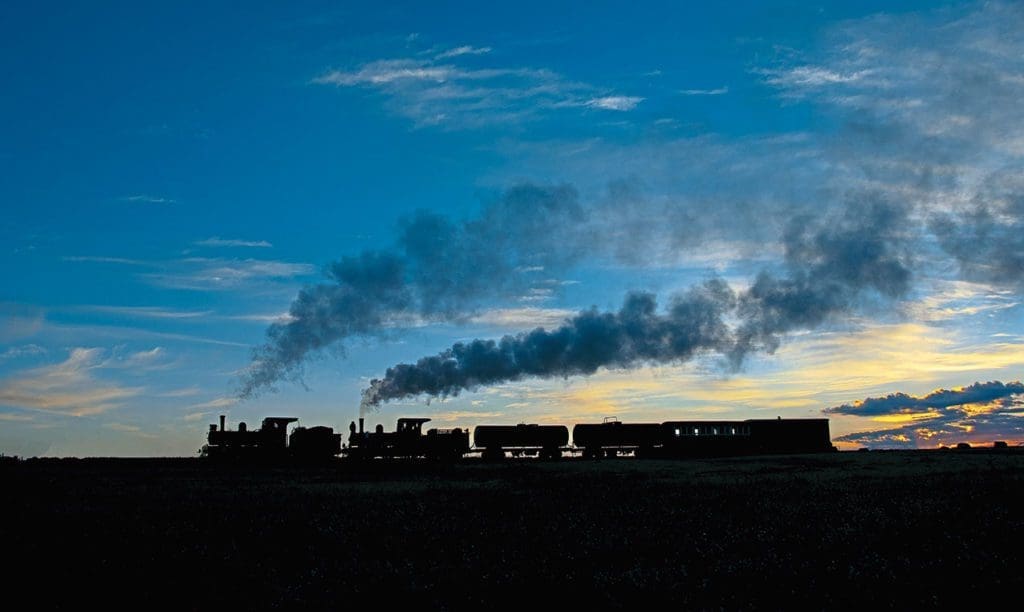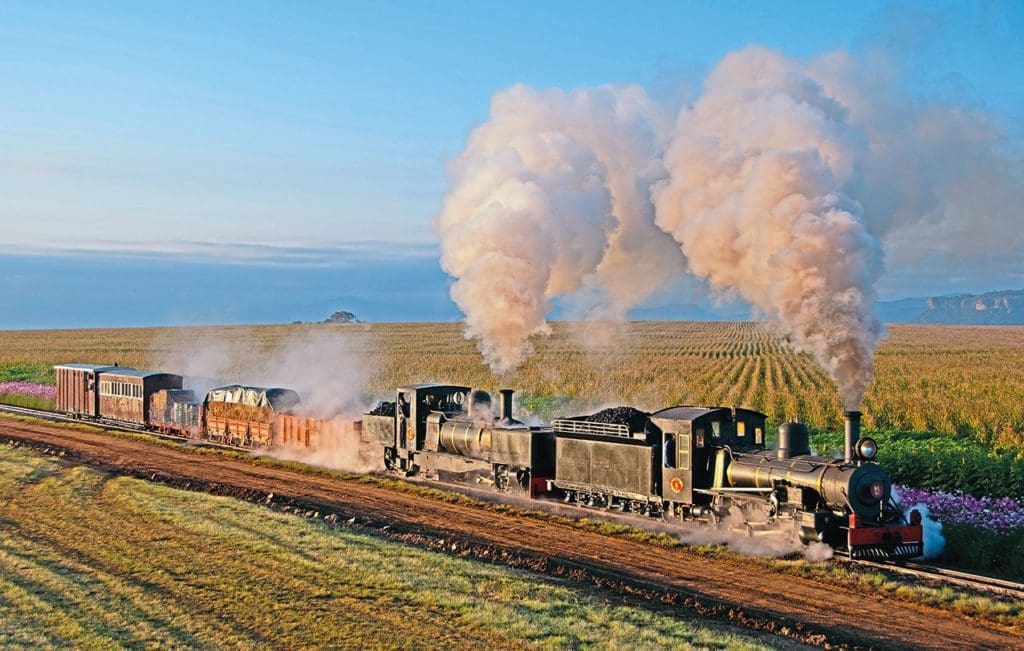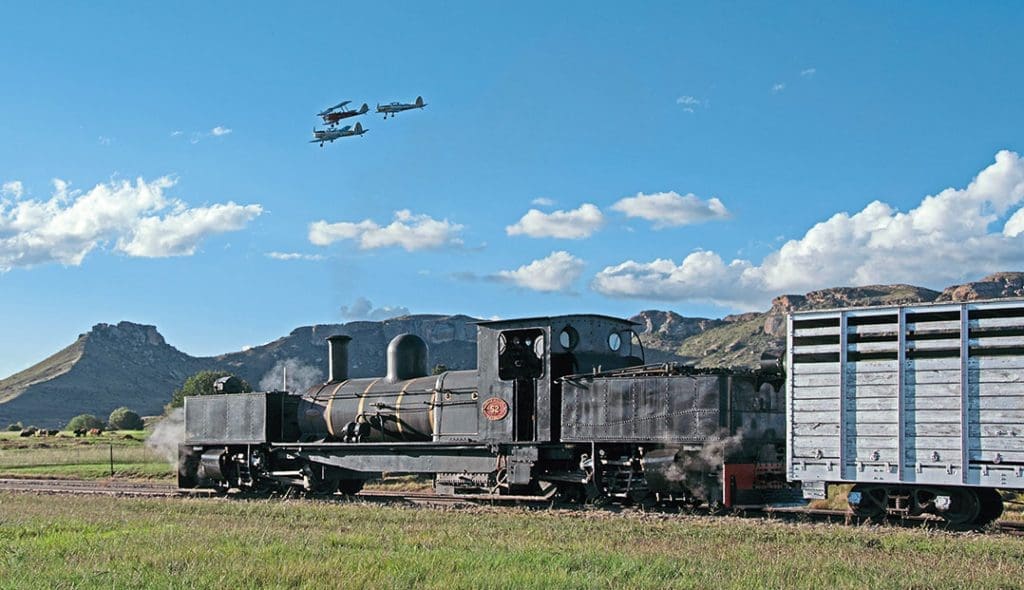Words & Photos: John Titlow
John Titlow visited this year’s International Sandstone Festival, which was set to be the biggest 2ft gauge event ever held in the southern hemisphere. His verdict: it was the finest in the world!
Here he reports in words and pictures on this showpiece heritage railway event to beat all others – and British-built steam certainly made its mark.
Enjoy more Heritage Railway reading in the four-weekly magazine.
Click here to subscribe & save.
Sandstone is the sort of place you dream of if you are into any sort of historic transport and machinery. It has been on my bucket list for a number of years and I have watched with envy the photographic opportunities on offer.

If anyone told me it would be that good photographically, questions would have been asked. The International Sandstone Festival must be one of the largest heritage transport events in the southern hemisphere, if not the world and it became too much to resist so, biting the bullet, the decision was made to go.
Primarily, Sandstone Heritage Trust is a private preservation initiative established on a commercial arable farm growing wheat, maize and sunflowers covering 20,000 acres near Ficksburg in the Eastern Free State of South Africa. The farm is located under the Maluti Mountains along the Caledon River, which is the border with land-locked Lesotho and was bought by its present owner, a British-owned company, in 1995.
Local farmers had been preserving farming machinery and the previous owners were still using older-style vehicles rather than modernising, thus creating a historic time warp. The new owner saw a wonderful opportunity to preserve these farming methods, machinery and the essential skills needed to maintain them that are still used daily. It is now essentially a modern working commercial farm, but historic machinery is used where possible.
South Africa had a reasonable number of 2ft gauge lines and Sandstone Estates, under the leadership of Wilfred Mole, realised that no one was preserving or restoring them apart from a few items, so they took on the challenge with a vengeance leading up to where it is today.


It all started with a telephone call in 1997 when Sandstone bought enough narrow gauge equipment to build a small railway on a short length of track and returned a NGG16 Garratt to steam.
By doing this, it gained the attention of the public and enthusiasts, which spurred the company on to extend the system when stocks became available after other lines closed.
Initially, Sandstone did not set out to build a railway – but what a job it has done! Incidentally, Wilfred is not predominately a railway enthusiast, but a preservationist for all things heritage.
During the late 1990s with the end of regular steam on the main line, Bloemfontein shed lay dormant and was offered for rent. Sandstone saw this as an opportunity to create a works for rebuilding steam locomotives.
Lukas Nel, who has just recently retired, was a fitter and, with others, had worked at the depot for many years. Together they brought their expertise to Sandstone to rebuild more than 15 locomotives for use on the farm, some from an extremely sad condition. Their hard work and dedication is clearly seen on the railway. Bloemfontein shed is also home to what is essentially the NRM reserve site, with many standard gauge (3ft 6in Cape gauge) locomotives preserved there.
The running line was constructed using heritage machinery and is just over 16 miles long between Grootdraai in the south, reached in 1999, through Hoekfontein station to Vailima in the north, reached in 2001. At either end are balloons, so running round is unnecessary – what goes out chimney first returns the same way round.

There are water columns and passing loops at Hoekfontein, Mooihoek and Vailima. Gradients are in excess of one-in-30. Also, there is Sebs Railway, named after Wilfred’s grandson, running round a very large loop and this is used for demonstrating the smaller locomotives.
The main station and workshops are at Hoekfontein, where the purpose-built workshops are reached via a short branch off the main line connected by a triangle used for turning the trains.
The station building originally came from nearby Kommandonek on the Bethlehem to Bloemfontein main line. It was moved to the farm by the previous owners for storage, and once its origins were discovered, it was carefully dismantled and moved to its present location, where it continues to be used for the purpose it was originally intended.
Also on the main line at Vailima there is an industrial siding that was used for loading the wheat and maize grown on the farm. This year the world-renowned luxury Blue Train made an appearance travelling from Pretoria and was stabled at Vailima on the main line itself for two nights.
Passengers could hop off straight onto the narrow gauge trains at the nearby adjacent siding created by Sandstone.
This gives an idea of how little this line is now used, if at all.
Read the full feature in Issue 254 of Heritage Railway – click here for more.
Advert
 Enjoy more Heritage Railway reading in the four-weekly magazine. Click here to subscribe.
Enjoy more Heritage Railway reading in the four-weekly magazine. Click here to subscribe.




